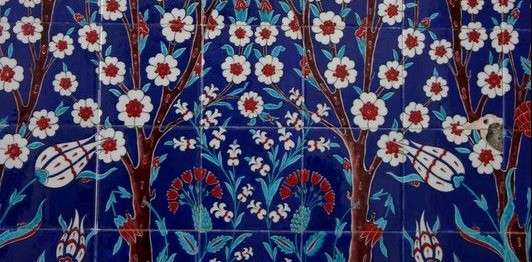Istanbul: The Tile Art Story
Overview and Highlights
Melling’s is an insider’s eye. But because the İstanbullus of his time did not know how to paint themselves or their city—indeed, had no interest in doing so—the techniques he brought with him from the West still give these candid artworks a foreign air. Because he saw the city like an İstanbullu but painted it like a clear-eyed Westerner, Melling’s Istanbul is not only a place graced by hills, mosques, and landmarks we can recognize, it is a place of sublime beauty.” ― Orhan Pamuk
Istanbul turned out to be one of my favorite cities in the world. I went without any expectations and was blown away by the country’s cultures, colors and scents. It is a dream destination, located in the edge of Europe where east meets west. Connecting the two continents, the city hides layers of history, culture and art. The architecture, the handicrafts, everything in Istanbul tells a story.
Below you’ll find an overview of the Tile Art story in Istanbul, and discover why tile art is the most widely known among the famous Turkish handicrafts. Some outstanding Tile artworks of the traditional culture and the contemporary world follow suit.
What is the historical connection between Turkey & Tile Art?
The history of Tile in Turkey, can be traced at least as far back as the Uighurs of the 8th and 9th centuries. It tremendously gained a spot among the various handicrafts in Turkey. Here two main decorative mediums can be categorized: Porcelain VS Ceramic tile. The subsequent development of tile art was influenced by Karakhanid, Ghaznavid, and Iranian Seljuk art.
In 1071, right after the Seljuks’ conquest over the Byzantines at Malazgirt in 1071, the handicraft followed them into Anatolia and embarked upon a new era of evolution fostered by the Anatolian Seljuk sultanate. Where the Anatolian Seljuks used square, rectangular, hexagonal, and triangular tiles to cover interior walls, floors and ceilings. These tiles were plainly ornamented, with turquoise, violet, or cobalt blue. While the earliest samples of the modern styles that emerged in the early Ottoman period are the ‘blue-and-white’ Iznik ceramics.
The Art of the Seljuq Period in Anatolia (1081–1307)
The Saljuq period can be regarded as an epoch in which handicrafts and architecture in Persia reached maturity. Although little has survived, a fascinating development took place in the techniques of tile Art. The outline has widened to include different motifs and styles of decoration changed from late derivatives of the post-Samarra beveled style towards intricate arabesques and star patterns.
Iznik Art
In the 17th century, Iznik became an important tile fabrication center of the Ottoman Empire. Floral motifs were regularly used on tiles. Animal prints like birds and fish, as well as human and ship figures were also used to ornament Iznik tiles. The most distinctive characteristic of the 16th century Iznik tiles and ceramics is the red color added to the blue-white adornment and became the most distinctive element of this Iznik art in the 16th century.
What is the difference between ceramic and porcelain tile?
For many, both “ceramic” and “porcelain” can get thrown around interchangeably, as if they were the same substance. Nevertheless, porcelain is more solid than ceramic bodies of the past; it is made up of denser clay and baked in an oven to befall a far more resilient composition. Porcelain is essentially the ceramic of the future, it is a modified ceramic body which has been refined from its original recipe which once included iron and hence had a red structure.
Nowadays the high quality porcelains are characteristically embodying a white structure. Ceramics however, are limited to wall applications due to the lack of strength.
To summarize, the art of Turkish tile, handicrafts and ceramics has broadly urbanized over the centuries incorporating a variety of different techniques and styles. Enhanced by the arrival of the Seljuks, the ceramic industry in Anatolia realized a worldwide reputation with the support of the Ottoman court.
Today, Turkey has been invigorated as a central core of tile and ceramic-making. In addition, efforts are also being made in private workshops and educational institutions in Istanbul, and Iznik to keep the art of traditional Turkish tiles and ceramics alive and develop it so that it can tackle the burden of our modern-day life.
Got inspired by reading this article ?
You May Also Want To Read: CLOSER LOOK AT MOSAIC PIETRA DURA
Don’t Forget to Subscribe to our Newsletter for More Updates on Mosaic Art, Decor, Creativity and Much More! You can also explore Mozaico for mosaic art of your own!











